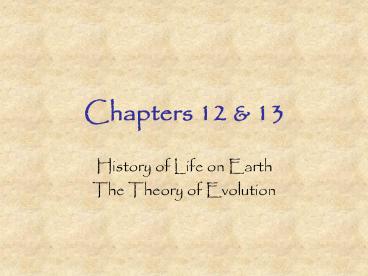Chapters 12 PowerPoint PPT Presentation
1 / 20
Title: Chapters 12
1
Chapters 12 13
- History of Life on Earth
- The Theory of Evolution
2
Chapter 12 - History of Life on Earth
- Section 1 How Did Life Begin?
- Section2 The Evolution of Cellular Life
- Section 3 Life Invaded the Land
3
The Age of Earth
- The Earth formed about 4.5 billion years ago
- Scientist have measured the age of the rocks
found on Earth using radiometric dating
(radioactive isotopes) - Half-life - time it takes for half of the
radioactive isotope to decay. (K-40) - Water vapor in atmosphere condensed to form the
oceans
4
Theories
- The Primordial Soup Model - basic chemicals of
life could have formed spontaneously - The Bubble Model- suggests that the key processes
that formed chemical of life took place within
bubbles on the oceans surface
5
Precursors of the First Cells
- Scientist have not been able to produce DNA and
proteins in water, but have been able to form
short chains of RNA. - Scientists think that RNA and RNA enzymes
catalyzed the earliest proteins and DNA - The concept of how life might have originated
naturally or spontaneously remains a subject of
intense interest, research, and discussion.
6
Evolution of Cellular Life
- Scientist have found fossils of earliest
prokaryotes that are 2.5 billion years old - Cyanobacteria - oldest marine, photosynthetic
made oxygen - 2 groups of prokaryotes (Eubacteria, and
Archaebacteria)
7
Evolution of Eukaryotes
- Eubacteria- contain chemical (peptidoglycan) in
their cell walls - cause disease and decay - Archaebacteria- lack pepti. In cell wall, but has
unique lipids in cell membrane - 1st Eukaryotic
cells came from Archaebacteria
- 1.5 billion years ago the first eukaryotes
appeared. - Eukaryotes have complex system of internal
membranes. - (nucleus, mitochondria, chloroplast)
- Mitochondria and chloroplast have own DNA
8
Life Invaded the Land
- Sun provides life-giving light and dangerous UV
radiation - Ozone formed from oxygen in atmosphere and
protects against UV radiation from the sun
9
Life on Land
- 1st - plants and fungi living together
(mutualism) mycorrhizae, lichens - Arthropods- hard outer skeleton (insects)
- Fish- vertebrates, (live in water, ancestors)
- Amphibians-vertebrates (reproduce in H20)
- Reptiles- vertebrates (reproduce on land)
- Mammals and Birds - vertebrates
- Continental Drift and extinctions led to evolution
10
Chapter 13- Theory of Evolution
- Section 1 Theory of Evolution by Natural
Selection - Section2 Evidence of Evolution
- Section3 Examples of Evolution
11
Charles Darwin
- 1831 Darwin was naturalist aboard the HMS Beagle
- Darwin found evidence that species gradually
changed over time - He found fossils of extinct armadillos that were
different than present day armadillos. - Galapagos Islands-examined finches and compared
them with S. American finches. They were slightly
different
12
Evolution by Natural Selection
- Individuals that have physical or behavioral
traits that better suit their environment are
more likely to survive and will reproduce more
successfully than those that do not have such
traits - Adaptation- species have changed in response to
particular environment
13
Darwins Theory
- 1) Variation exists within the genes of every
population or species (result of mutation or
translation errors) - 2) In a particular environment, some individuals
are better suited to survive and reproduce
(natural selection) - 3) Over time, the traits that make certain
individuals able to survive and reproduce are
spread in that population. - 4) There is overwhelming evidence from fossils
that living species evolved from organisms that
are extinct.
14
Darwins Ideas Updated
- Reproductive isolation condition in which 2
populations are separated by geography and cant
reproduce - Punctuated Equilibrium rapid change in a species
followed by extended periods of no change
15
Evidence of Evolution
- Most scientists agree on the following 3 major
points - Earth is 4.5 billion years old
- Organisms inhabited Earth for most of its history
- All organisms living today share common ancestry
with earlier life forms
16
Anatomy and Development / Biological Molecules
- Vestigial structures body structures that are
evidence of organisms past (examples hind limb
of whales) - Homologous structures structures that share
common ancestry (arm on humans, bats, alligators)
page 286 - examples
- Biological molecules- genes should have changed
over time by mutation and selection - Humans and gorillas have only 1 difference in
amino acids in hemoglobin - Page 287
17
Factors of Natural Selection
- 1) All populations have genetic variation
- 2) The environment presents challenges to
successful reproduction - 3) Individuals tend to produce more offspring
than the environment can support - 4) Individuals that are better able to cope with
the challenges presented tend to leave more
offspring than those that can not cope.
18
Evolution of Antibiotic Resistance
- Mutant bacteria able to survive the antibiotic
and cause a resistance - Deadly in some cases (tuberculosis)
- Antibacterial craze that hit the world a few
years ago.. People still got sick
19
Evolution of Darwins Finches
- Darwin collected 31 specimens of finches from 3
of the Galapagos Islands. (9 different species) - He found the shape of the beaks to vary based on
what the finch ate (big beak more favorable
during dry years)
20
Formation of New Species
- Divergence accumulation of differences between
groups (leads to new species) - Speciation process by which new species form
(subspecies)

